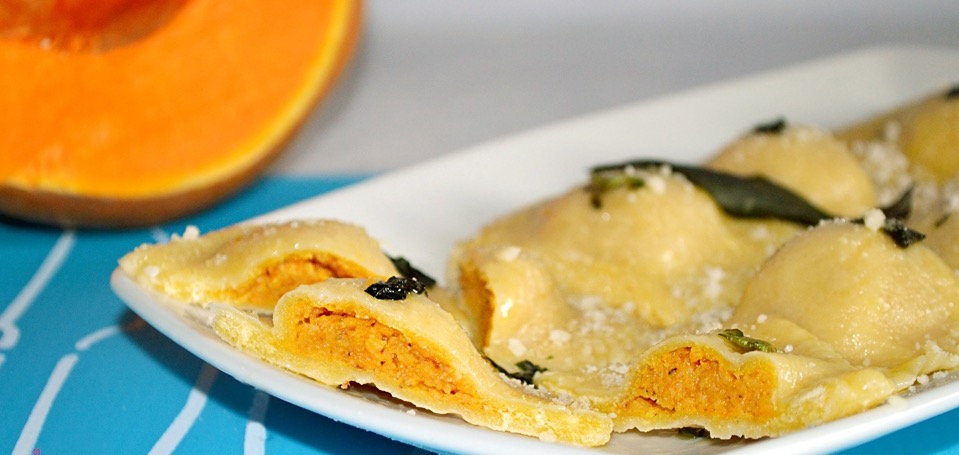The simplicity of Northern Italian flavors are perfect for anyone living in Long Island Wine Country or any agricultural region where fresh ingredients are always on hand.
On the North Fork we have such an abundance produce and during the autumn and winter the variety of of squashes and gourds is especially impressive. I love pumpkin anything from traditional desserts to savory soups and pasta. While making the rounds in Northern Italian wine country, I was enticed by the golden orange color of the main Lombardian dishes. The golden color of pumpkin or “zucca” that filled pockets of pasta to the saffron glisten of risotto alla Milanese or the color of yolk in a freshly baked panettone, this golden orange color remains prominent in the regal Lombardian cuisine.
Pumpkin is the feature in one of the best know Lombardian dish called tortelli di zucca (a kind of ravioli). It is slightly sweet from the combination of pumpkin and amaretti but is also savory from the salty cheese and silky, buttery sauce that tops this delicious dish. It is a great dish to prep on a Sunday afternoon and enjoy the leftovers for Meatless Monday.
Ingredients
Filling
1 ¾ lbs. Long Island cheese pumpkin (weighed after being peeled)
1/2 cup leftover amaretti cookies, dried and powdered
2 tbsp Mostarda Mantovana, finely chopped
1/2 cup Parmigiano Reggiano, finely grated
1 pinch nutmeg
Breadcrumbs
Salt to taste
Tortelli
1 1/3 cups flour
3 eggs
Sauce
5 ½ tbsp butter
6 sage leaves
Salt and Pepper
Parmigiano Reggiano, finely grated
To Make the Filling
Cut the pumpkin and bake it in a preheated oven at 140°C – 285°F for 40 to 50 minutes, or until soft. Let it cool down.
Cut out the skin (you can also bake the pumpkin without the skin) and put the pumpkin in a bowl.
Add the powdered amaretti, mostarda, Parmigiano Reggiano, nutmeg and enough breadcrumbs to make a firm and workable filling.
To Make the Tortelli
Put the flour and eggs in a food processor and mix. When the dough looks like crumbs, pour it onto the bench top sprinkled with a little flour.
Knead well by hand until you obtain a smooth dough. Make it into a ball, wrap it in cling wrap and let it rest for 10-15 minutes.
Cut out a piece of egg pasta dough and flatten it into a rectangular shape with your hands.
Put a little flour on it and begin passing it though the pasta machine. Turn the dial to the widest setting (#1) and, starting with one of the shorter sides of the rectangle, feed it through the rollers.
Now fold one side of the piece of dough into the middle, then fold the other side over that to form 3 layers.
Starting with one of the narrower sides of the folded dough, feed the pasta through the machine, again at the widest setting. Repeat the folding and rolling technique on the widest setting for at least a couple of times.
Now you can start rolling it thinner, by turning the dial to the next narrowest setting (# 2). Roll the pasta through the machine without folding the dough between settings. Keep reducing the settings until #7. If the sheet of pasta gets too long, you can cut it in half with a knife.
Cut out your lasagne sheets.
To Make the Sauce
Put the butter and sage in a small saucepan. Let the butter melt on a medium fire and gently fry off the sage in it. Remove from the fire as soon as it starts to bubble (you don’t want to brown it). Add a pinch of salt.
How to Assemble
Now put the filling with a tablespoon on one half of the sheet of pasta. Make sure to leave some space in between them.
Fold the other half of the sheet onto the filling and press well all around.
Make sure there are no air bubbles inside, or the pasta will open while cooking and the filling will come out. To seal the pasta use a little bit of water.
Cut around the filling in a squarish shape and remove the excess dough.
To Cook Al Dente
Fill a pot 3 quarters with water and add a handful of sea salt. When the water is boiling, add the pasta noting the exact time. Add a teaspoon of olive oil to the water so that the pasta doesn’t stick and stir it well and often while cooking. It should only take a few minutes for fresh pasta to cook. Pasta has to remain firm and not hard, and it is definitely NOT meant to be soft.
When the pasta is cooked, drain it and put it in the pan with the butter and sage sauce. Mix well on low heat for a minute.
Serve hot with some thinly grated Parmigiano Reggiano on the top.




